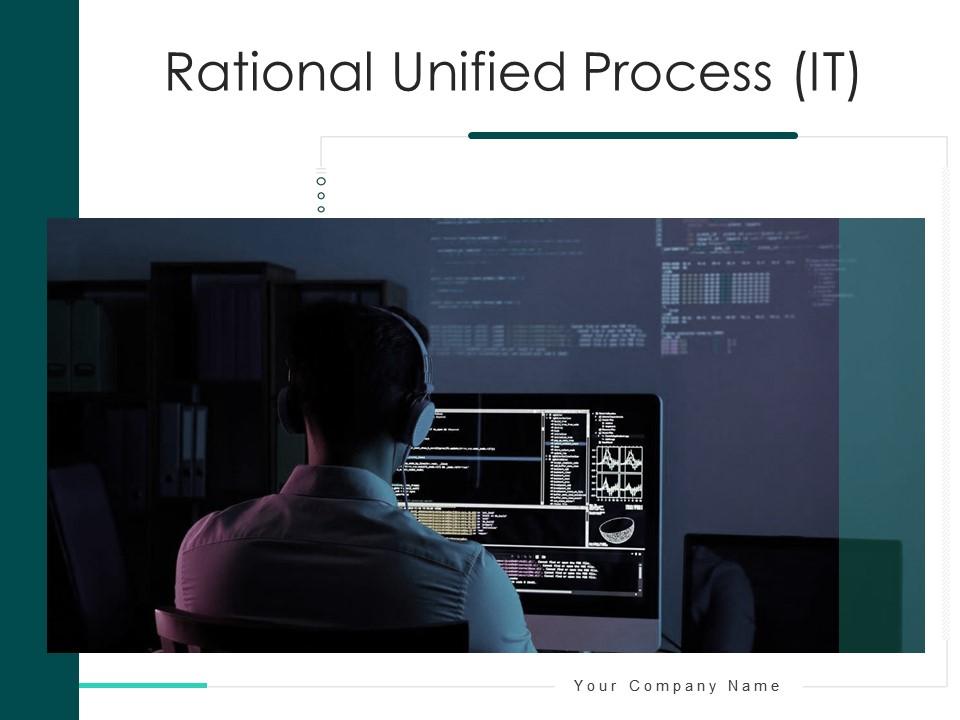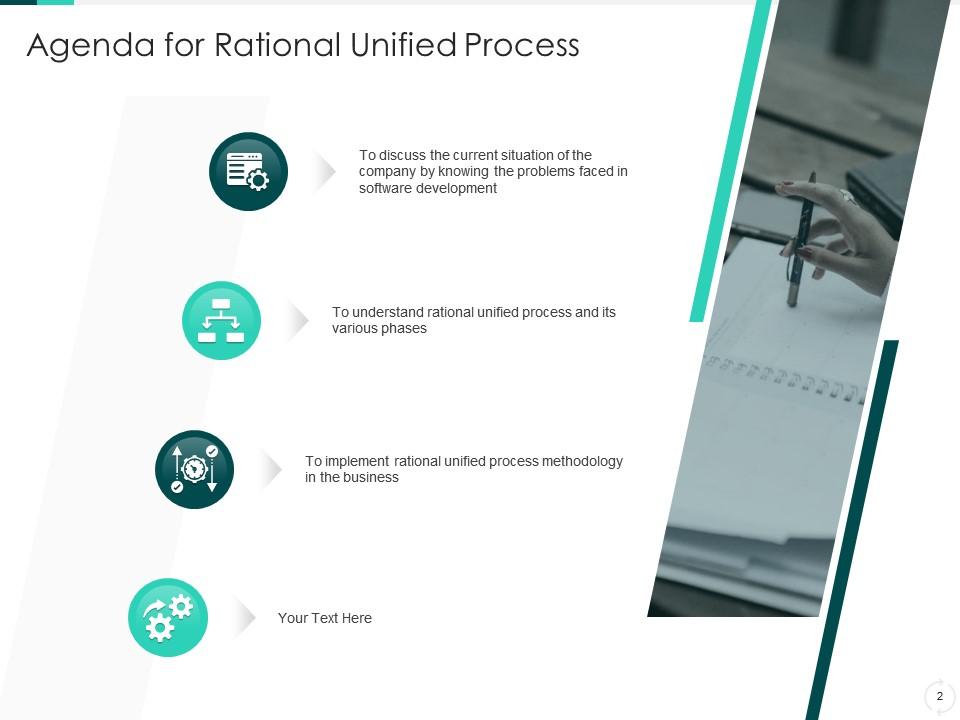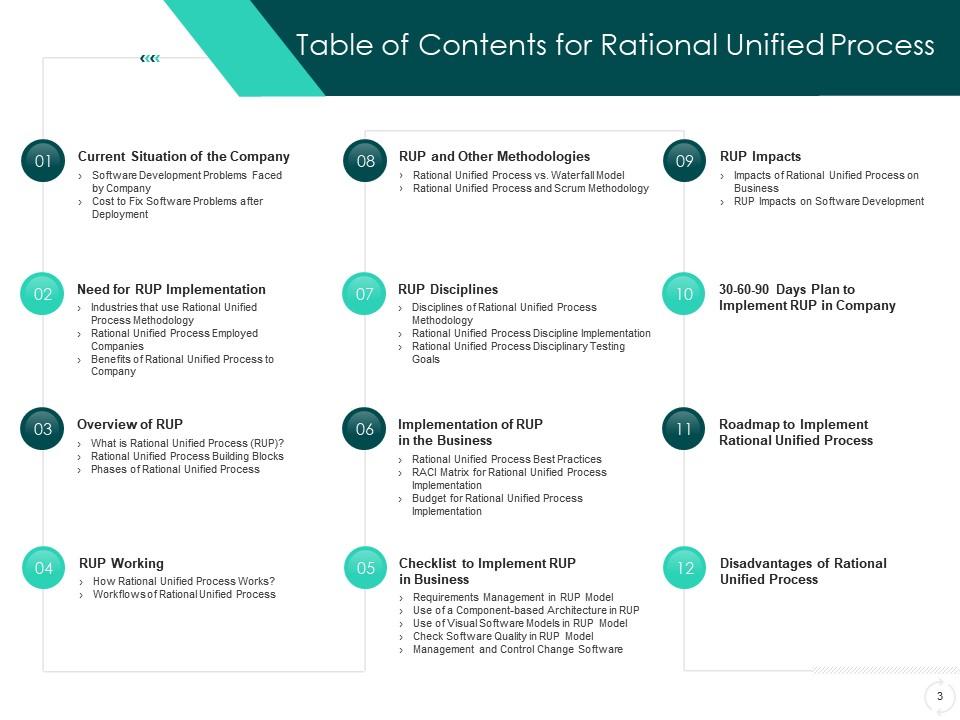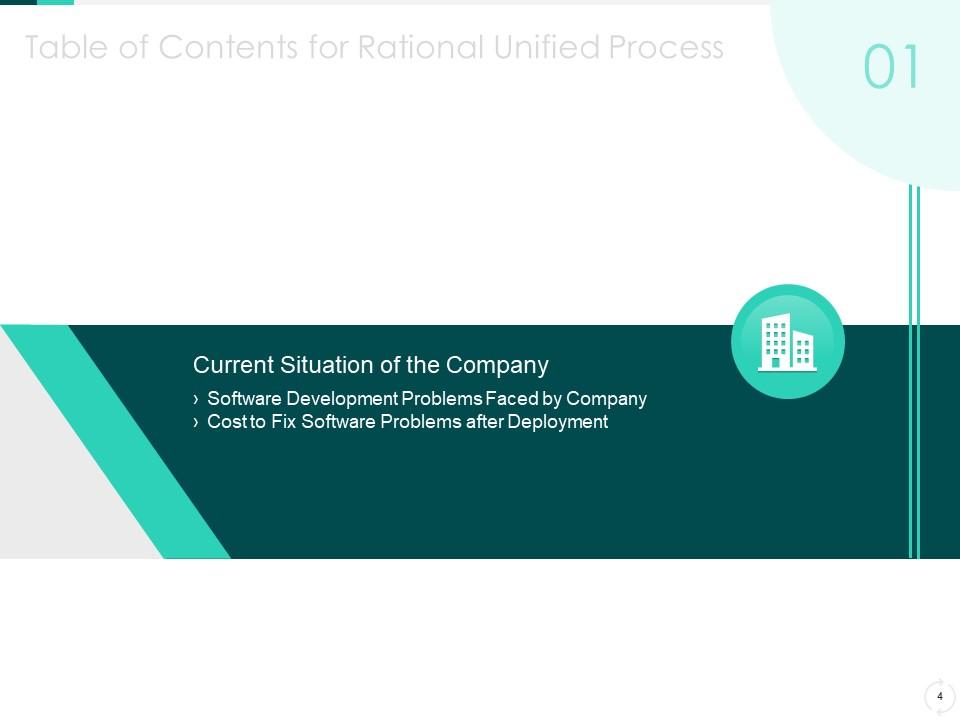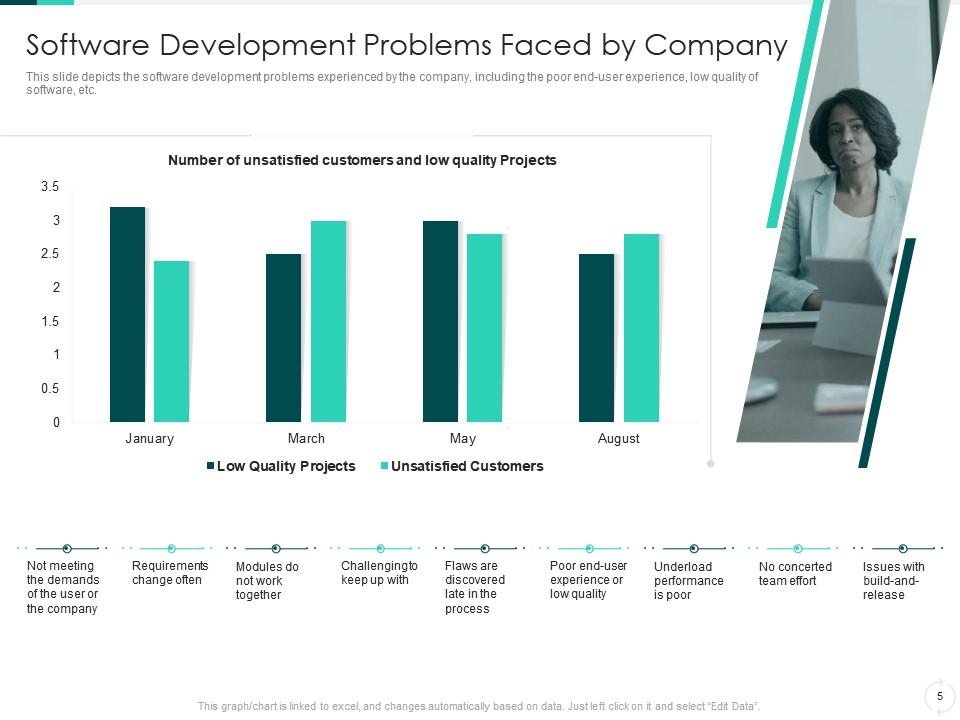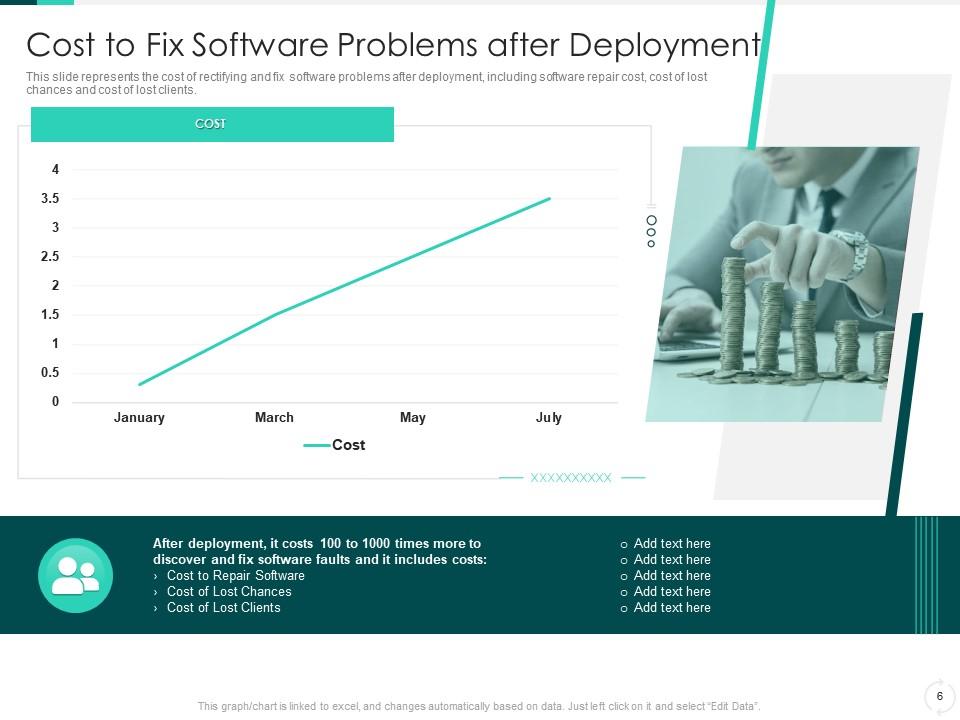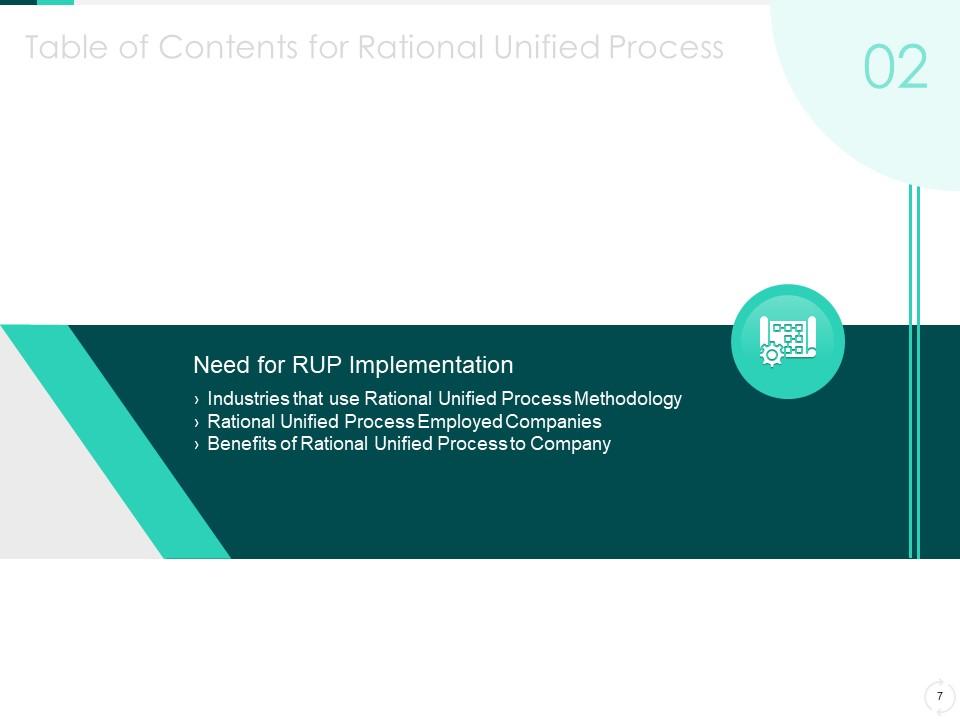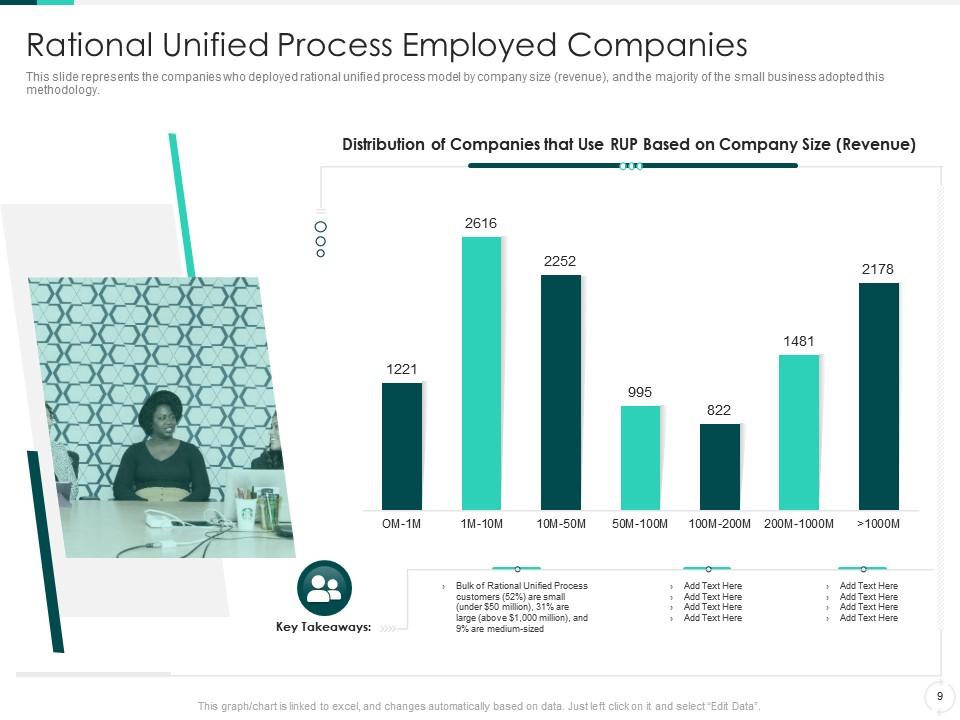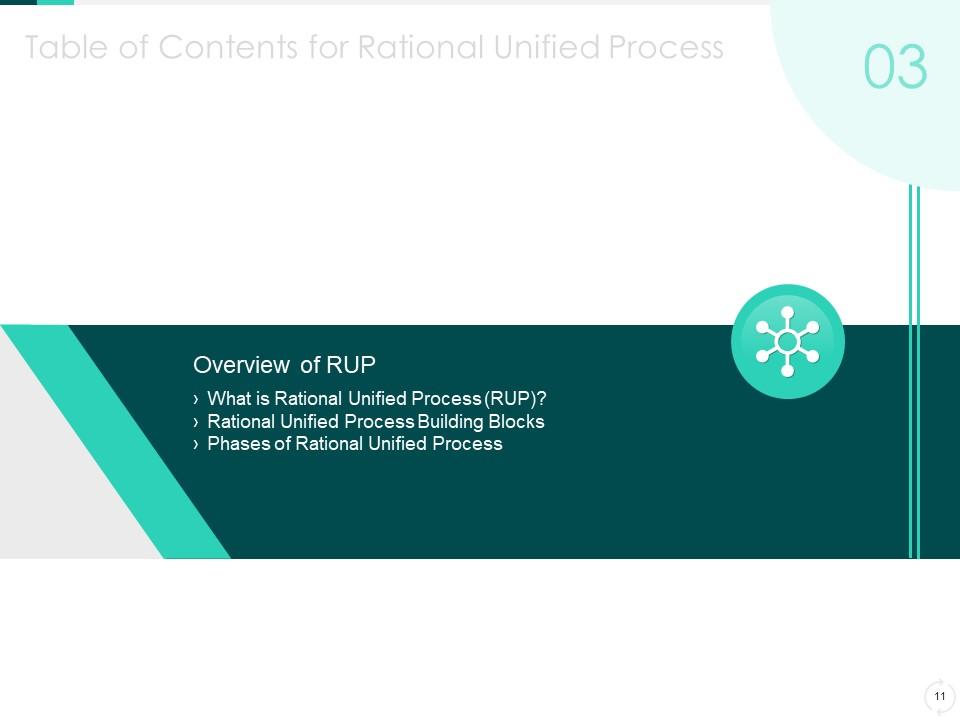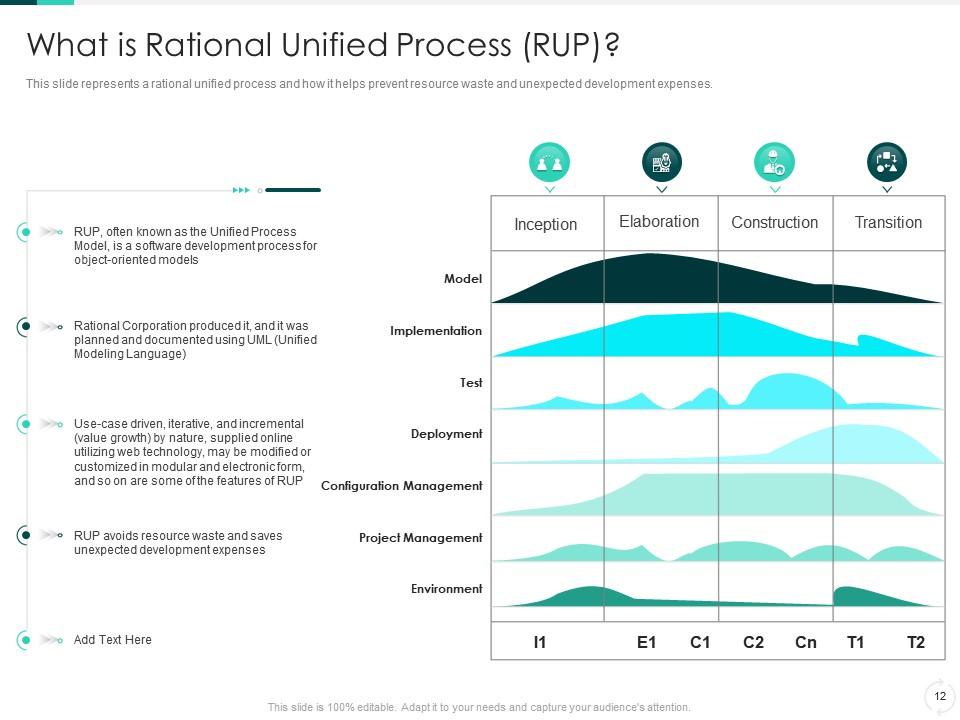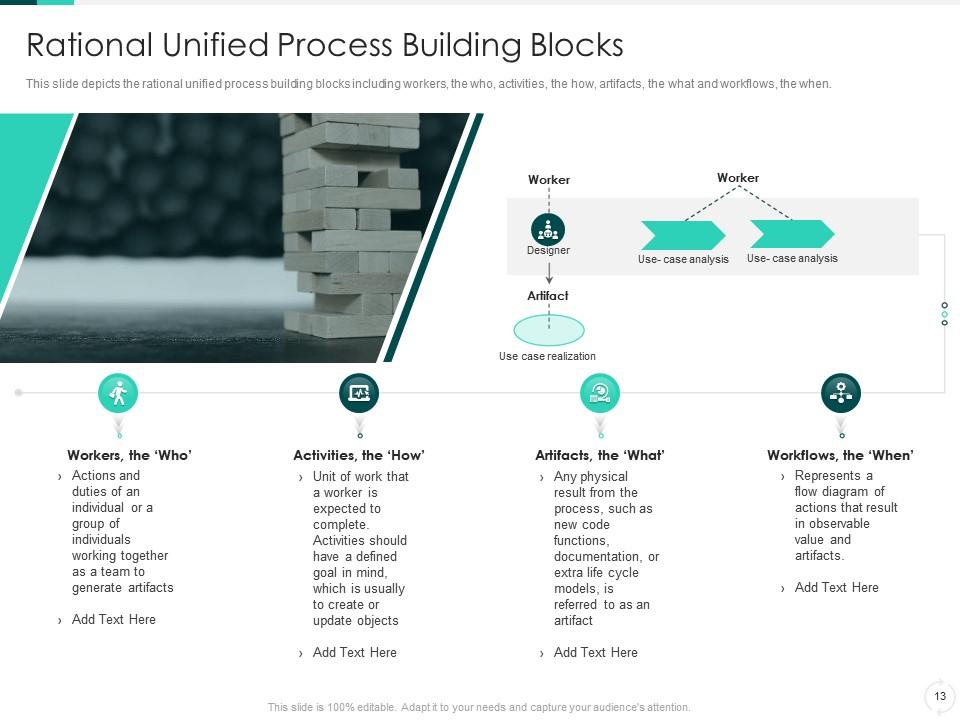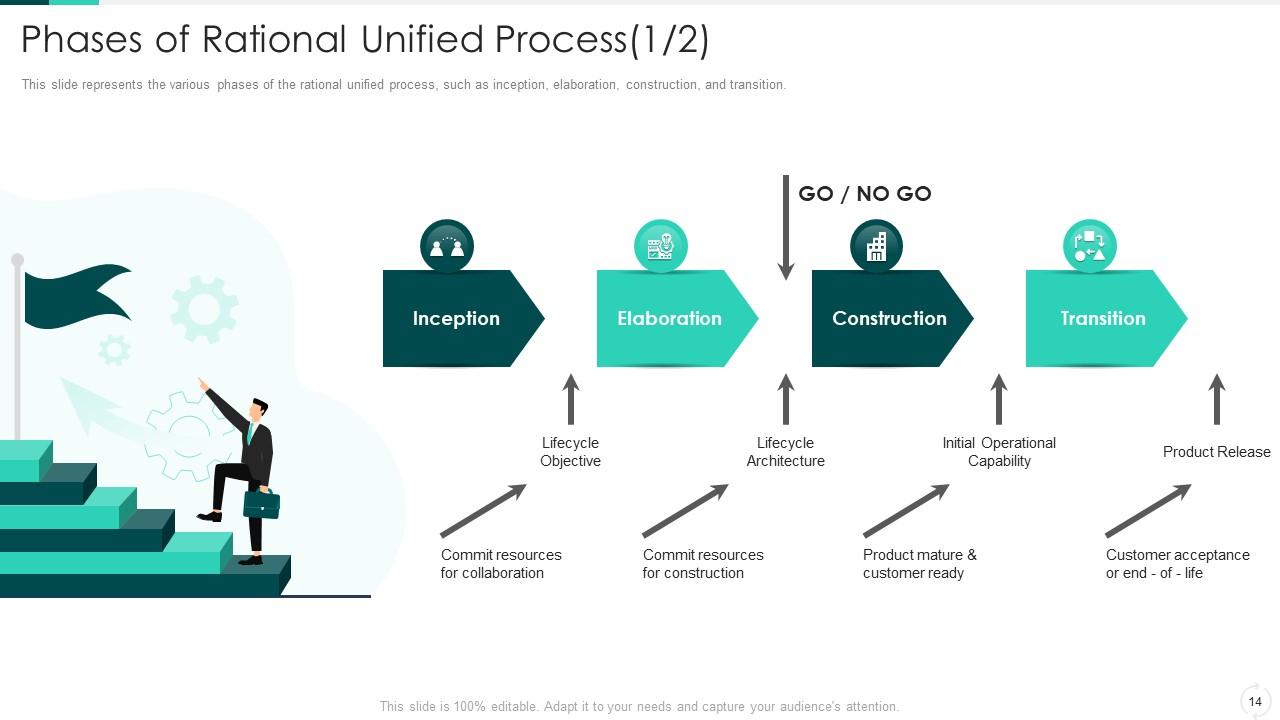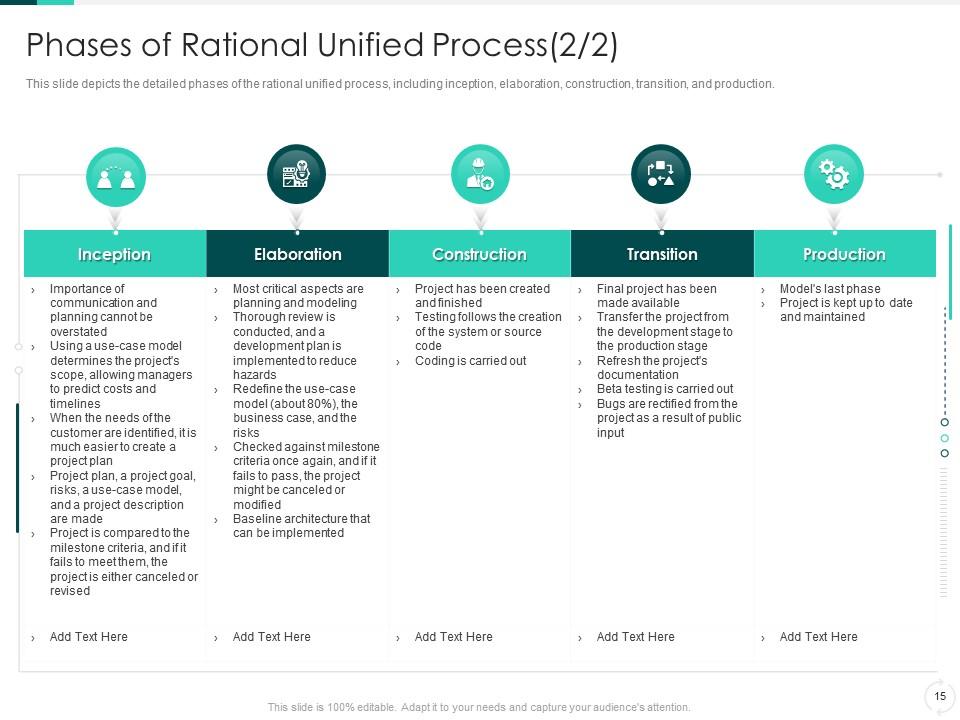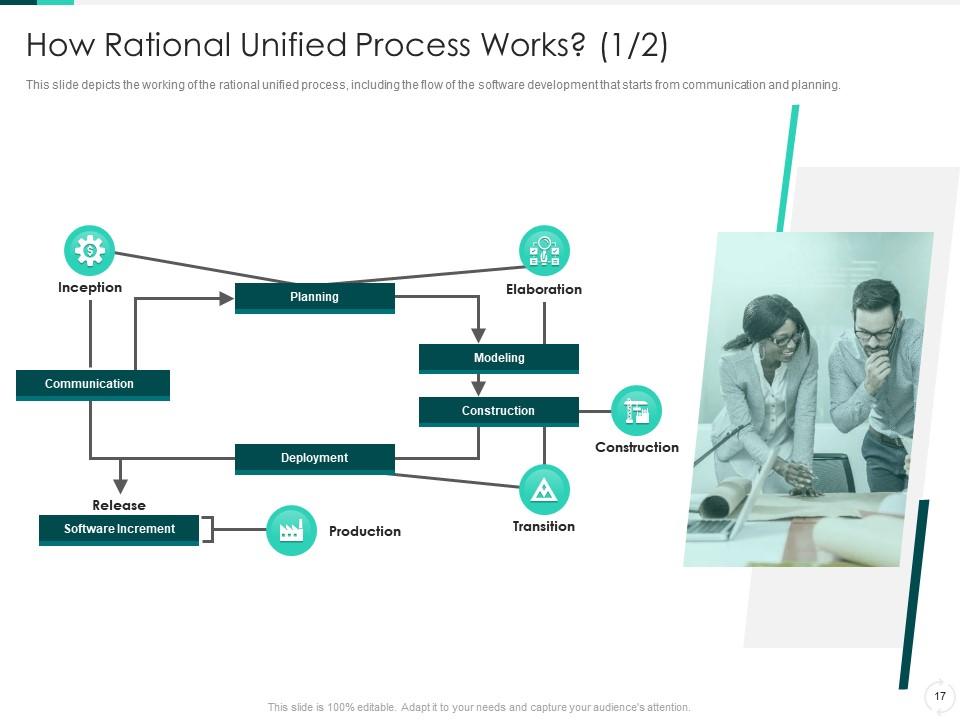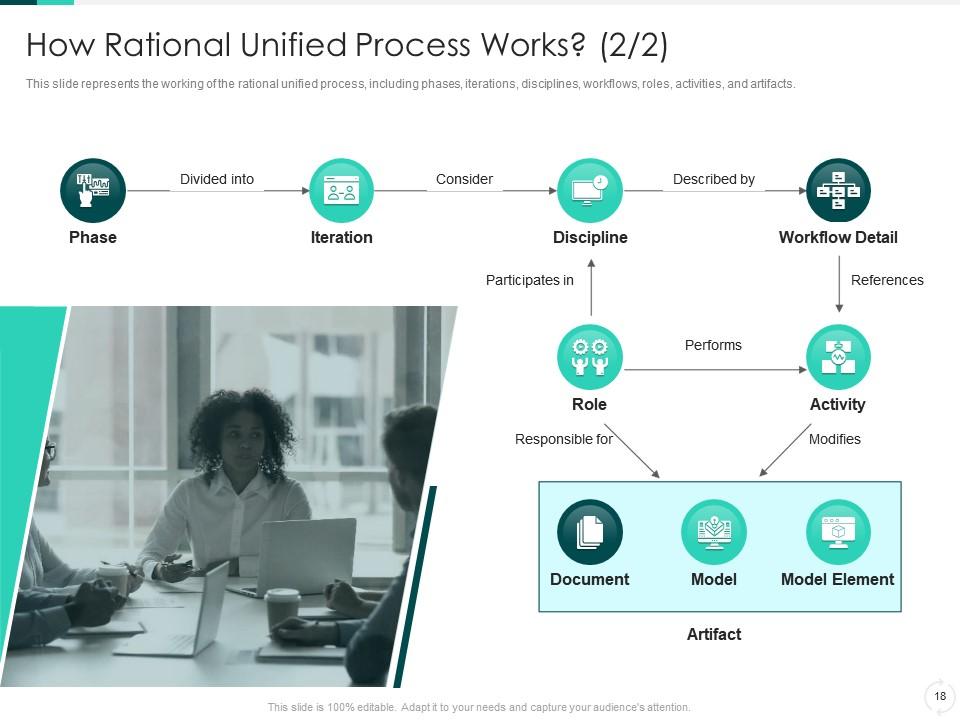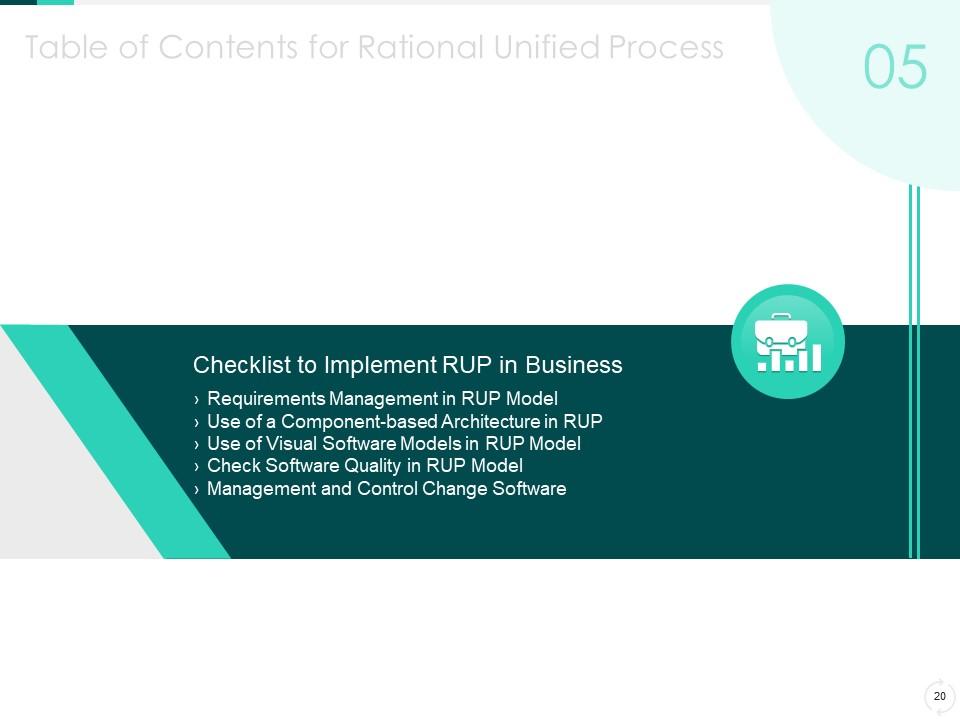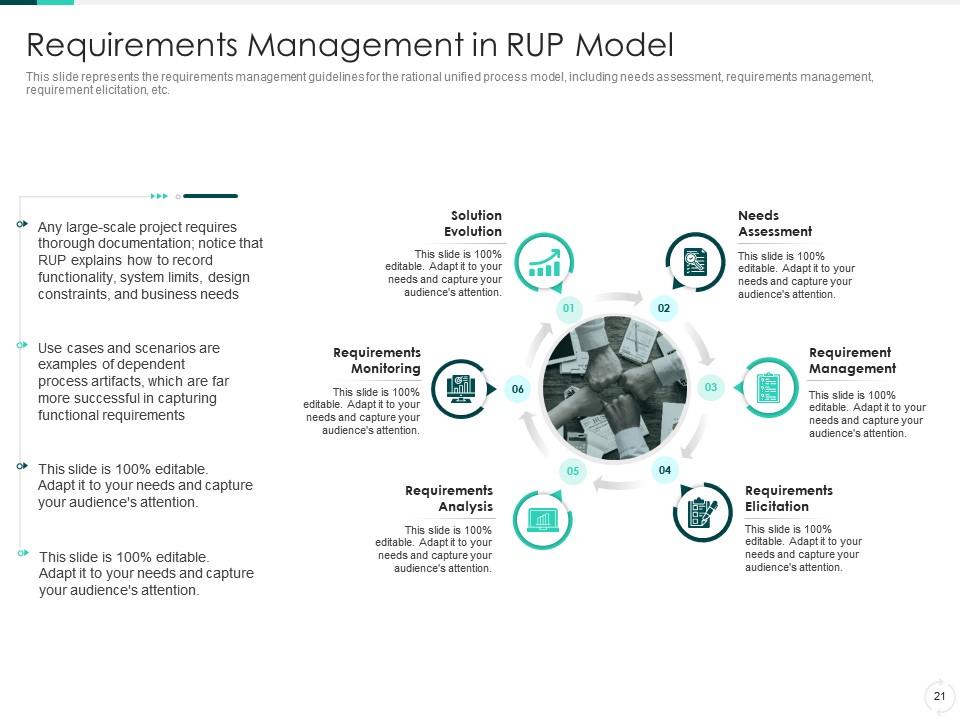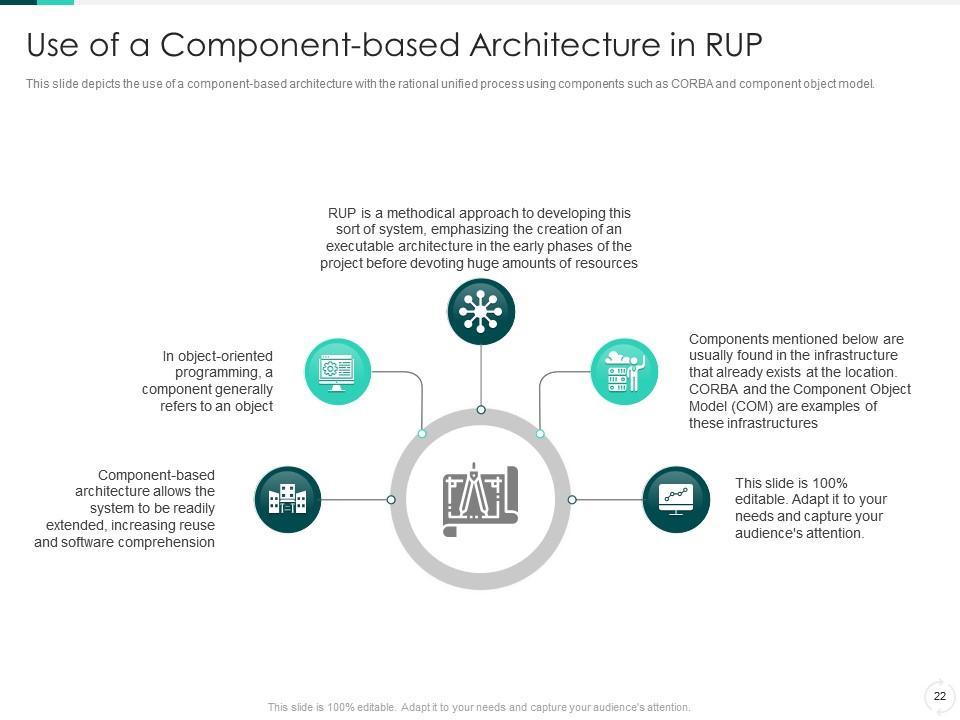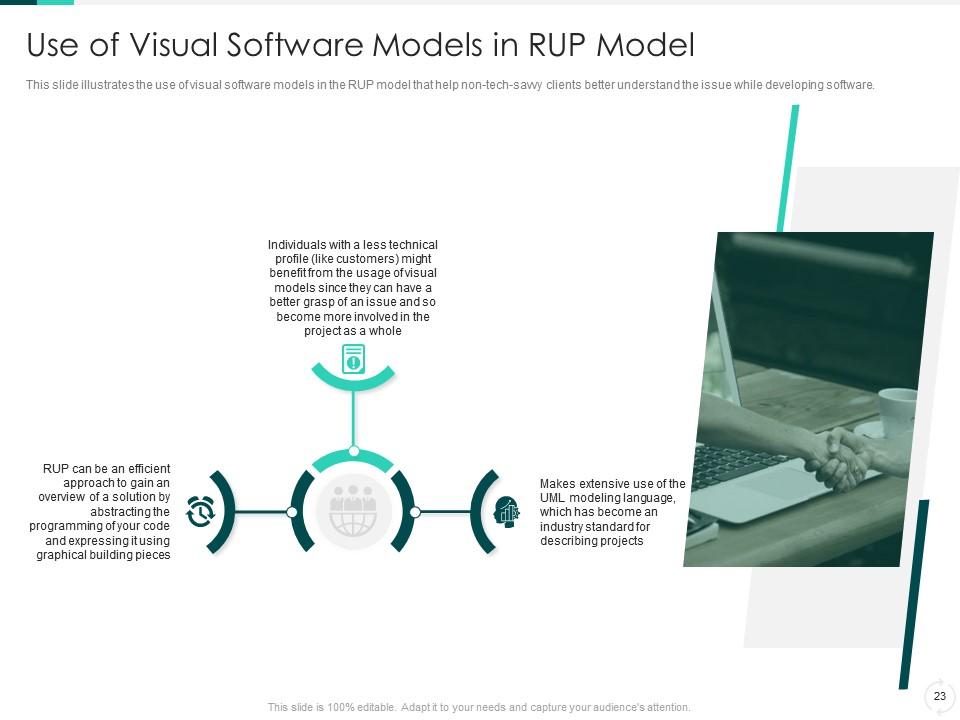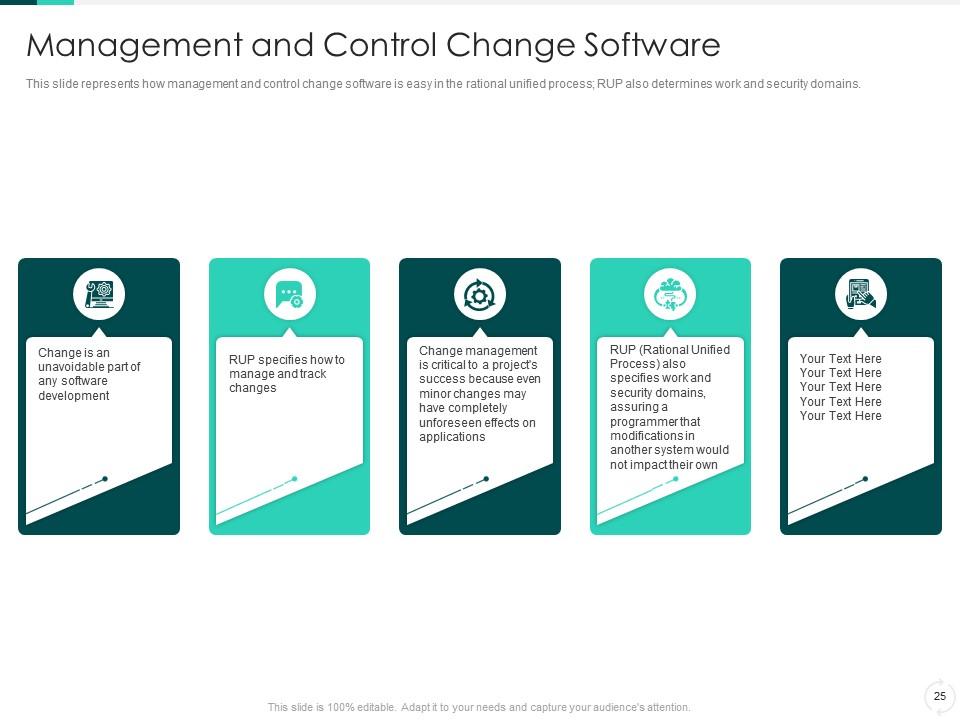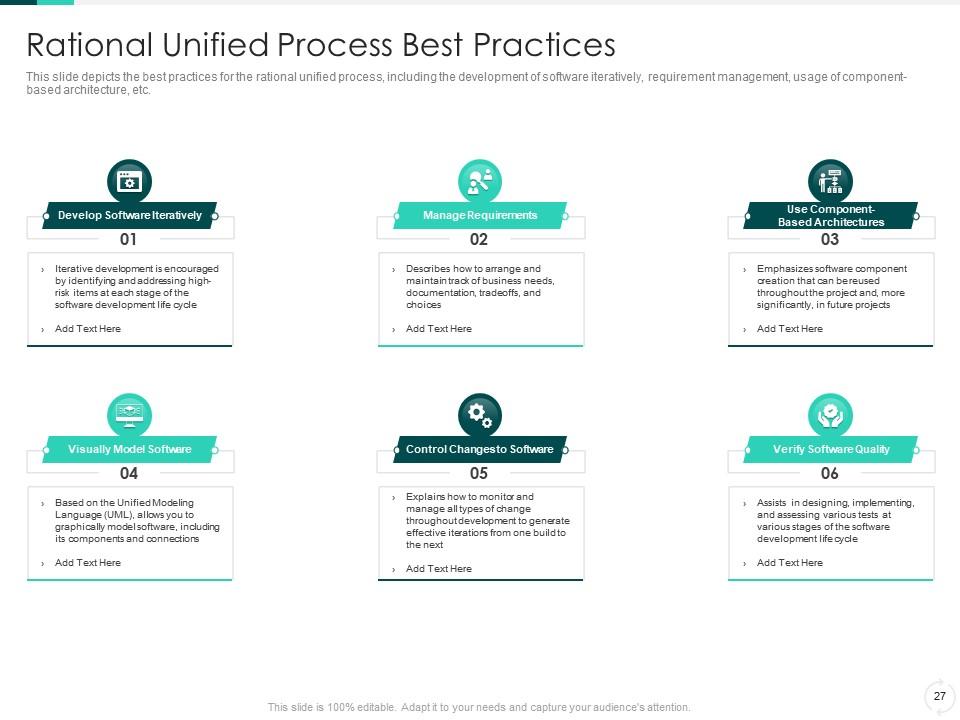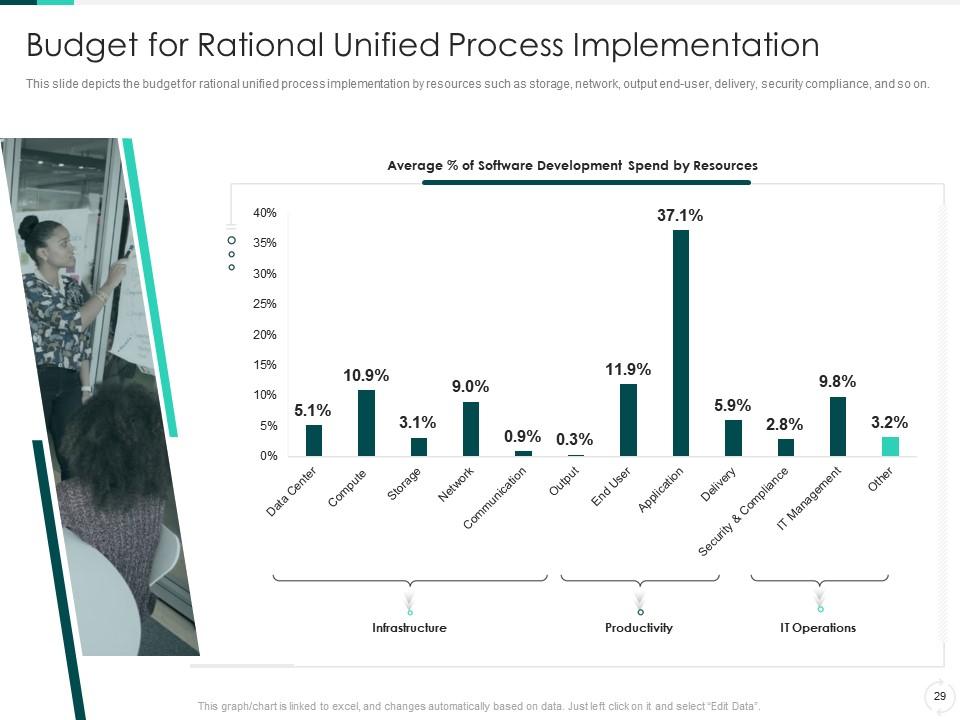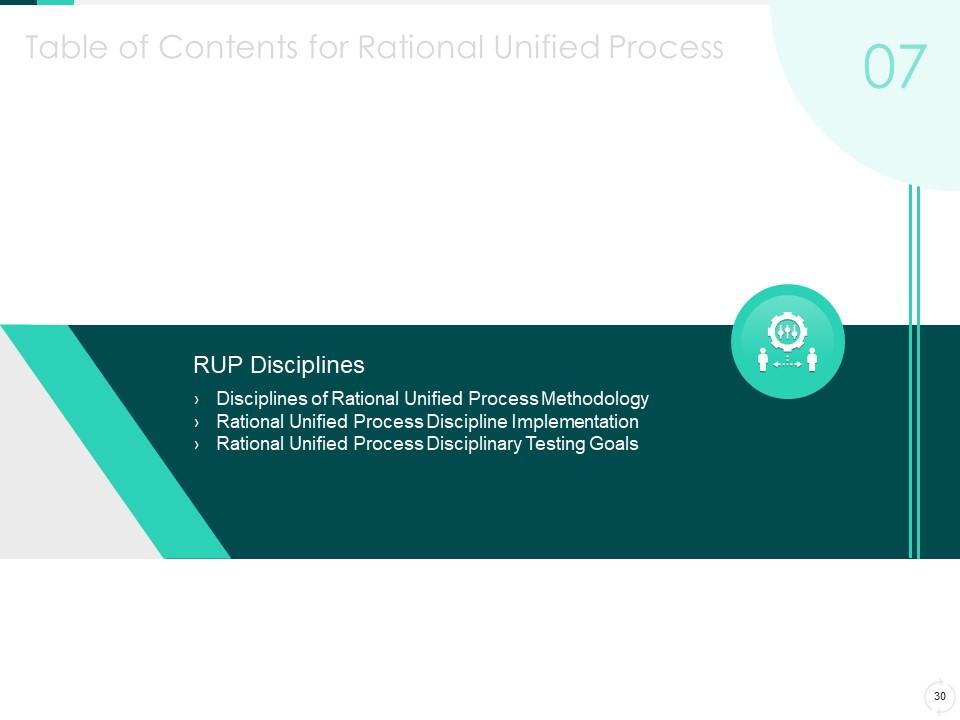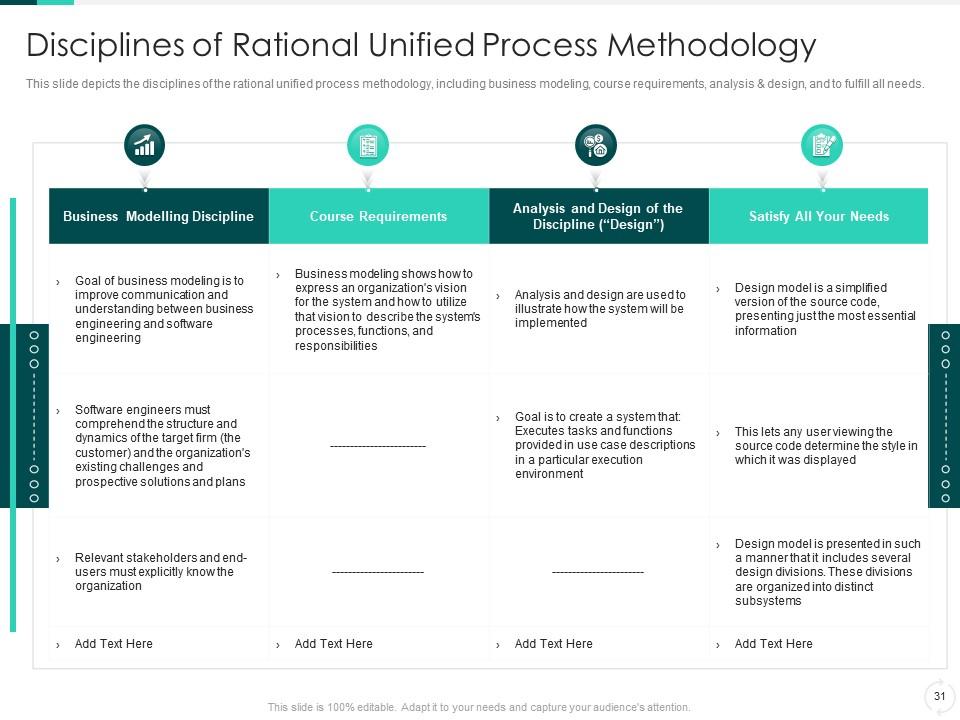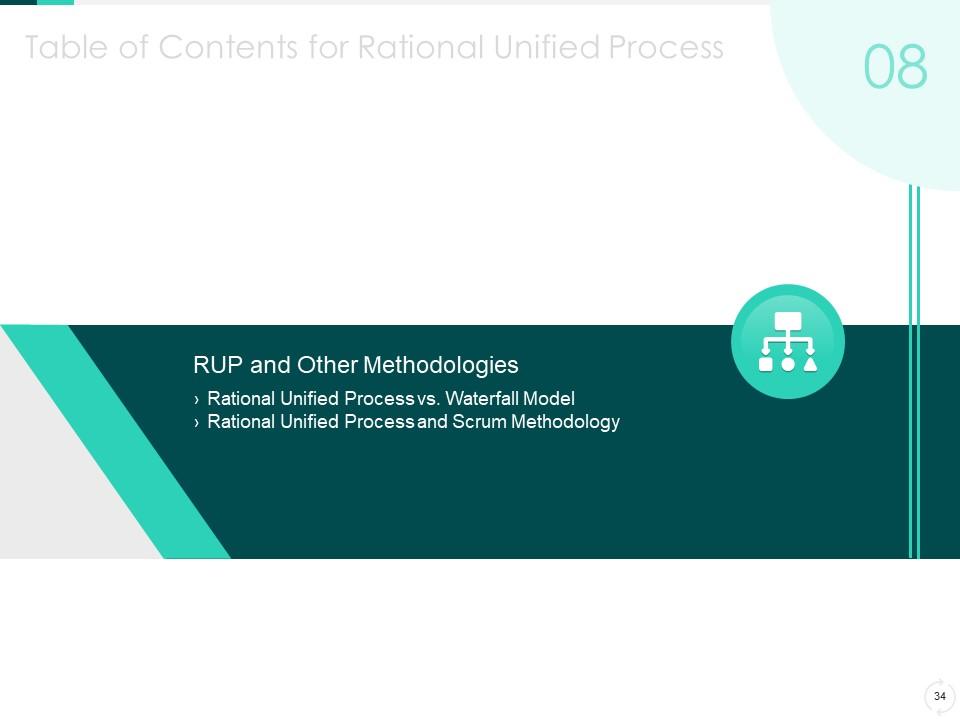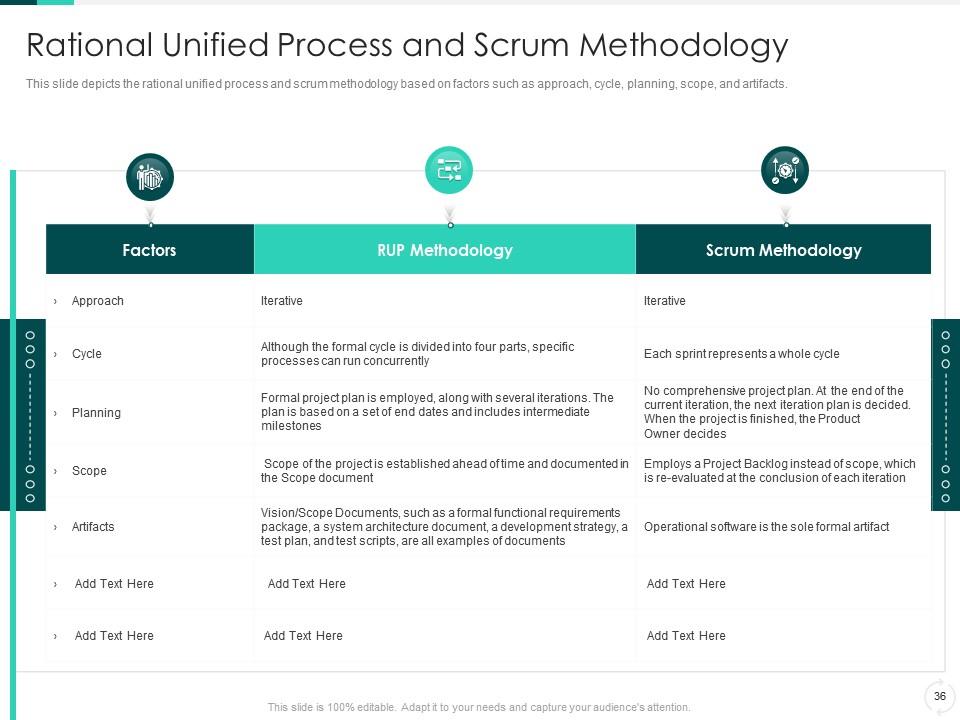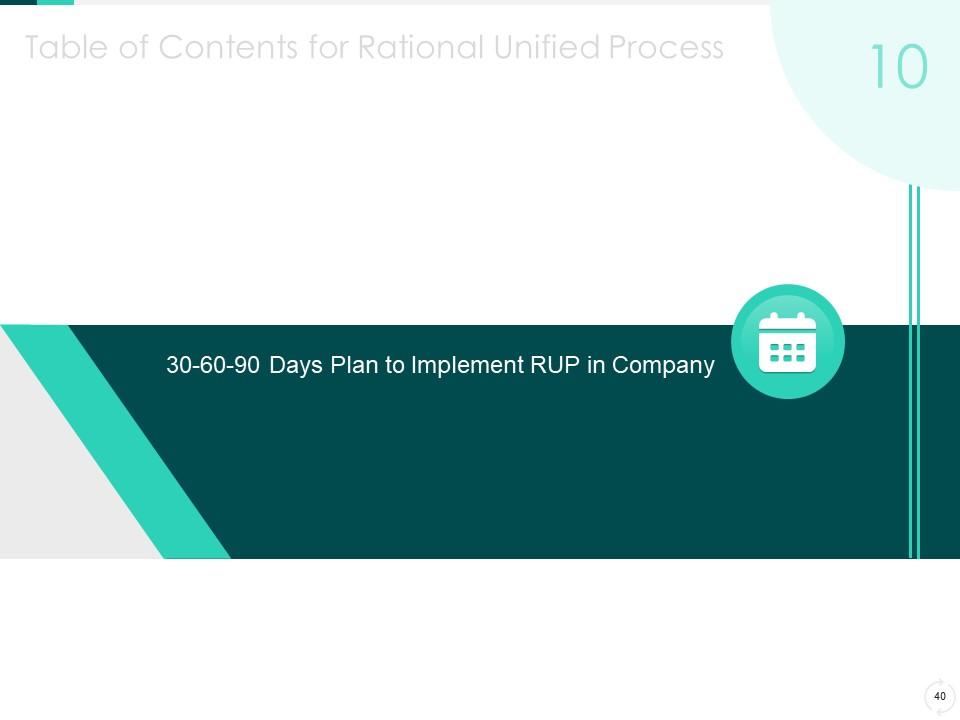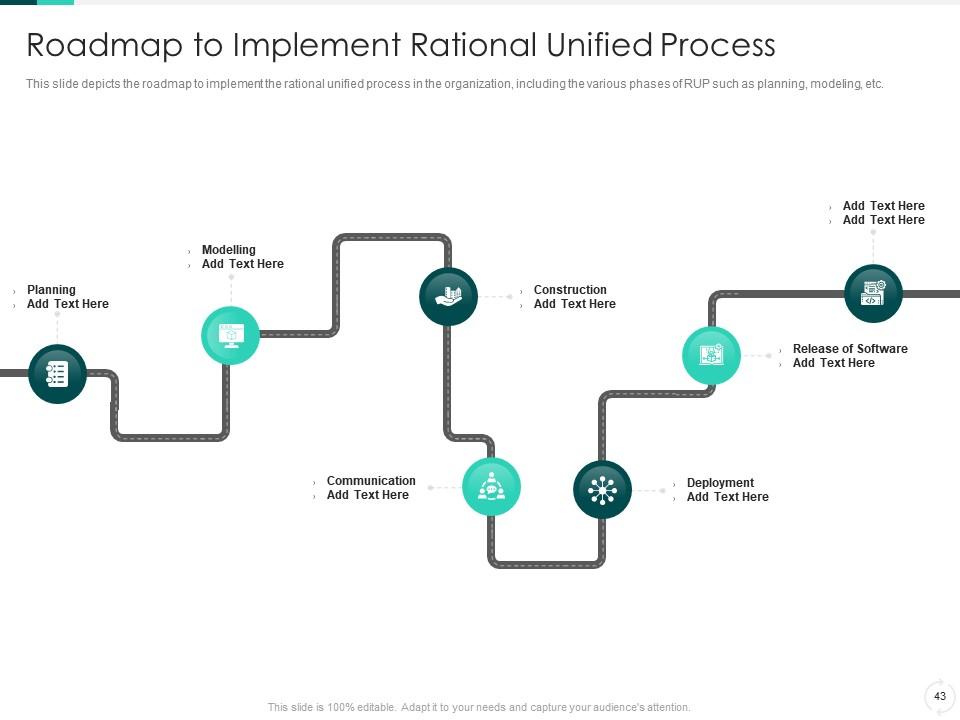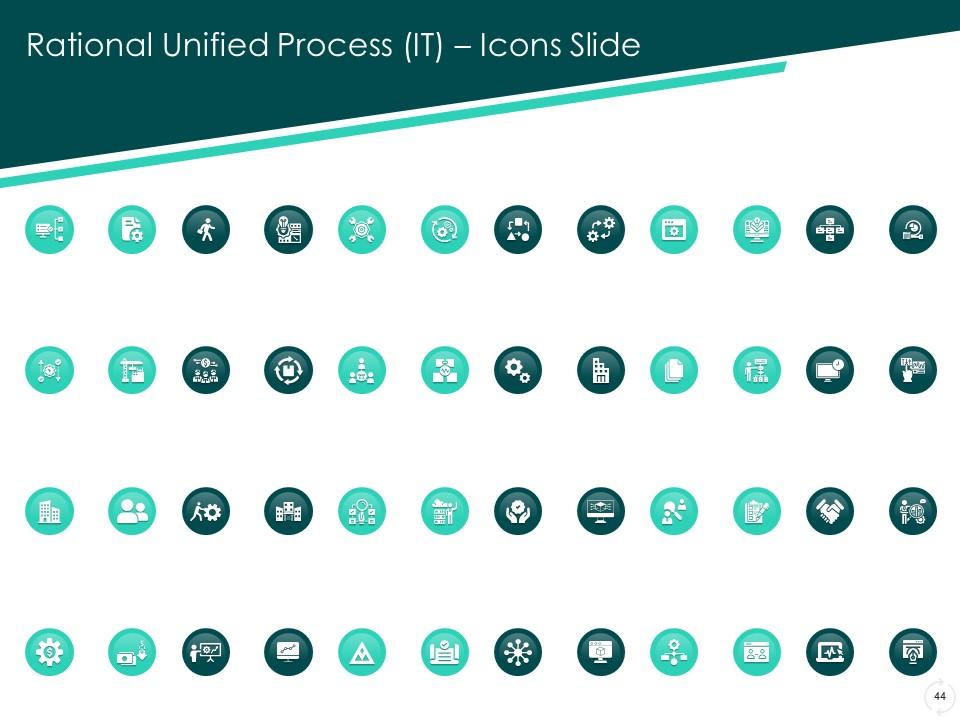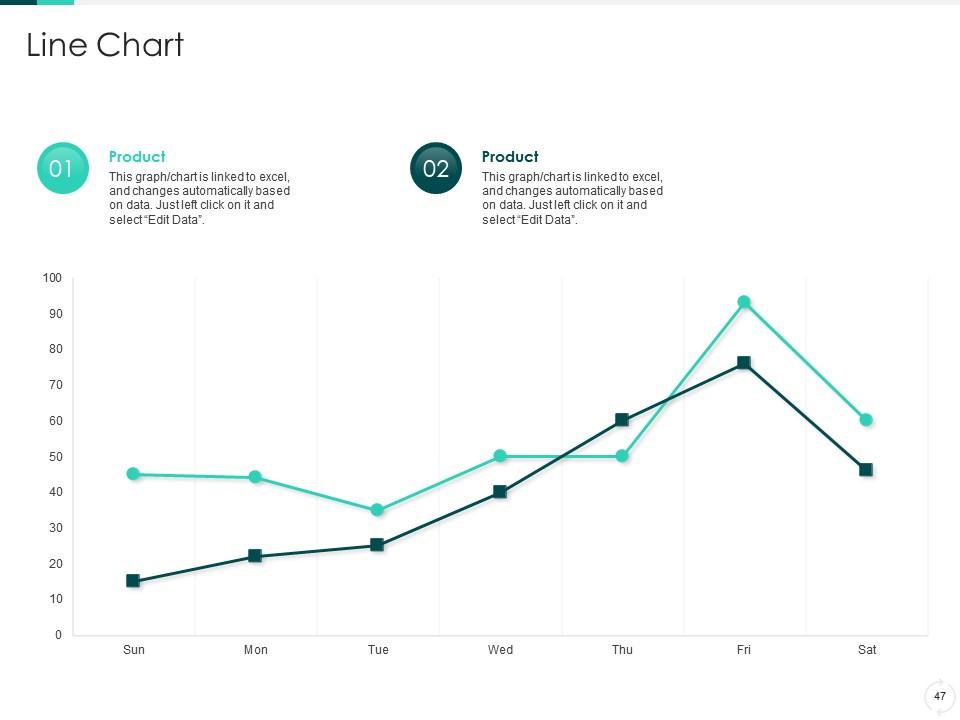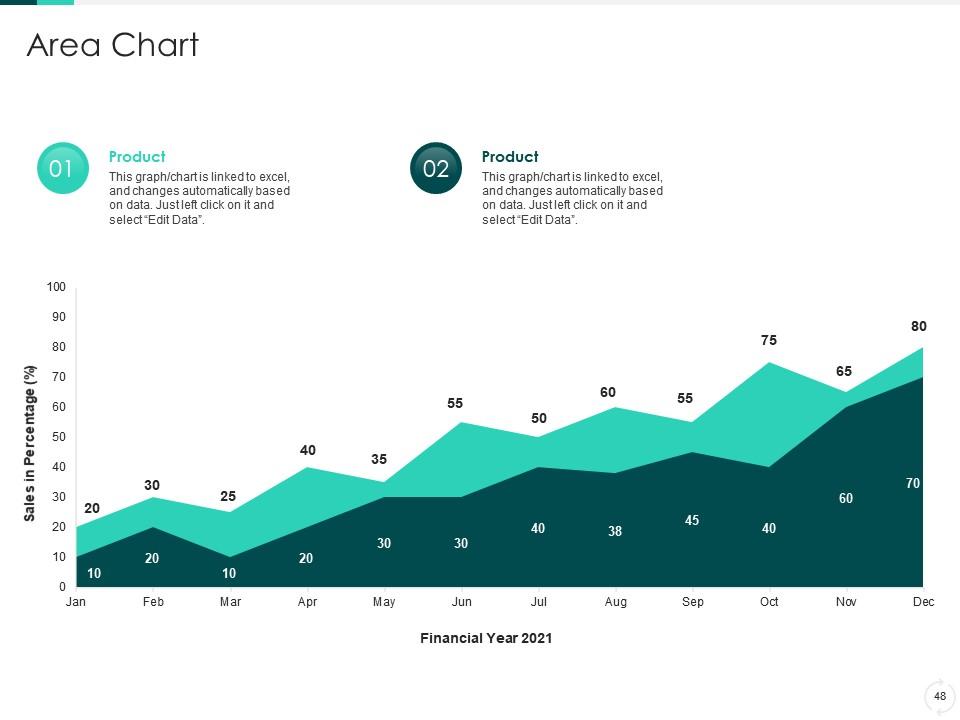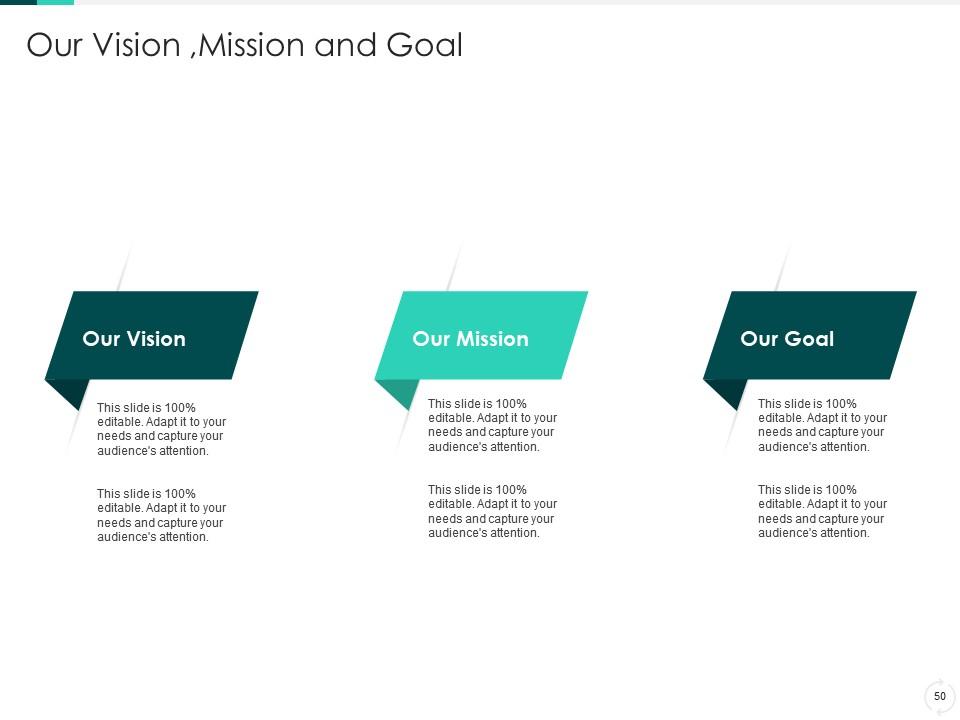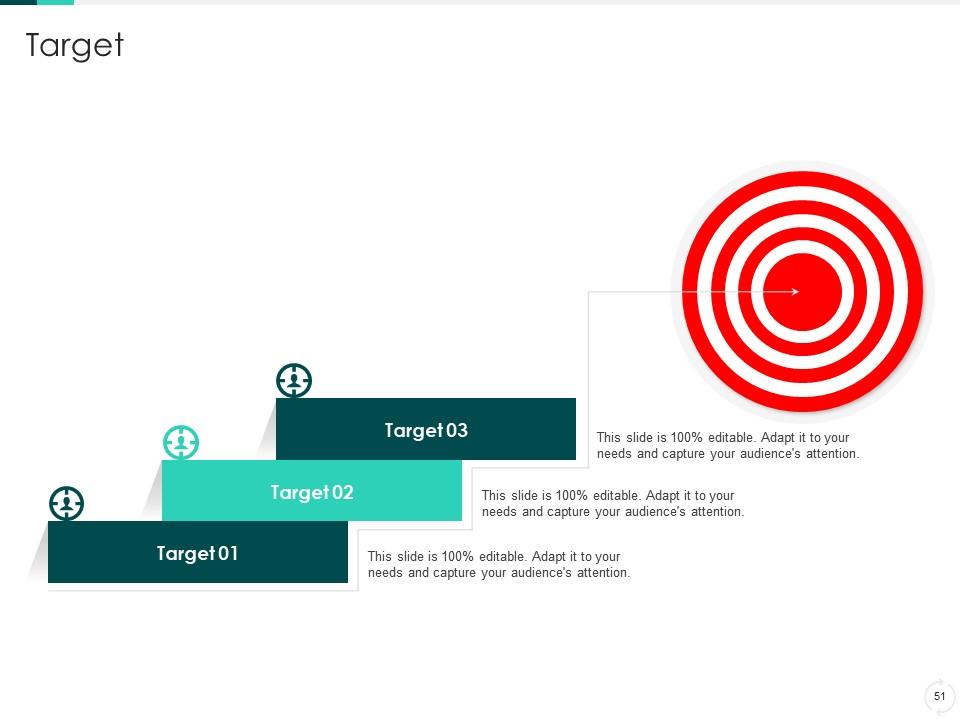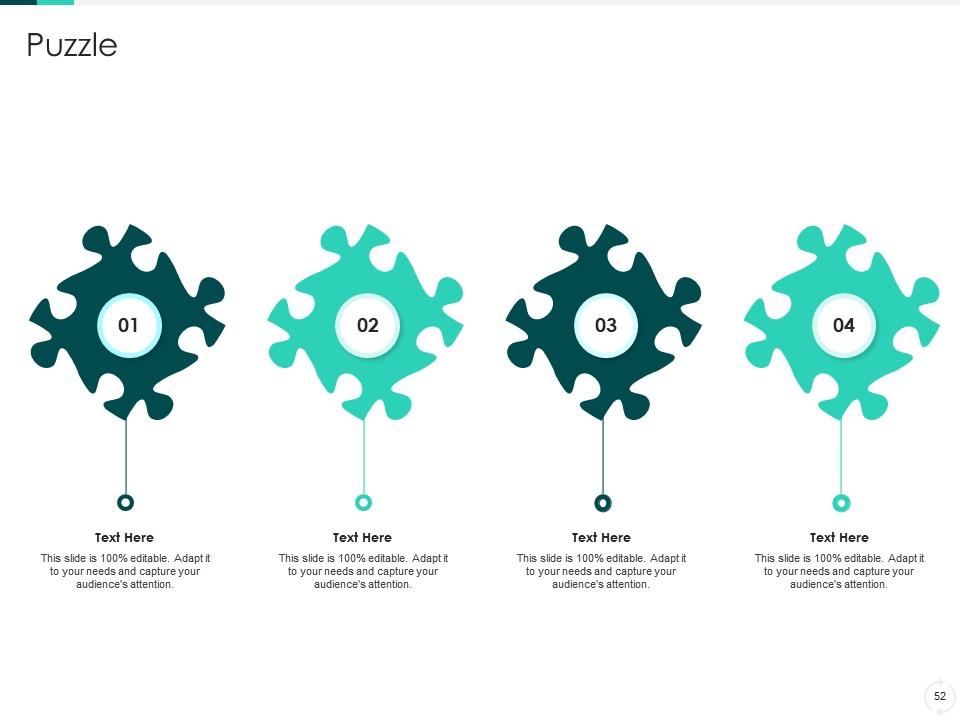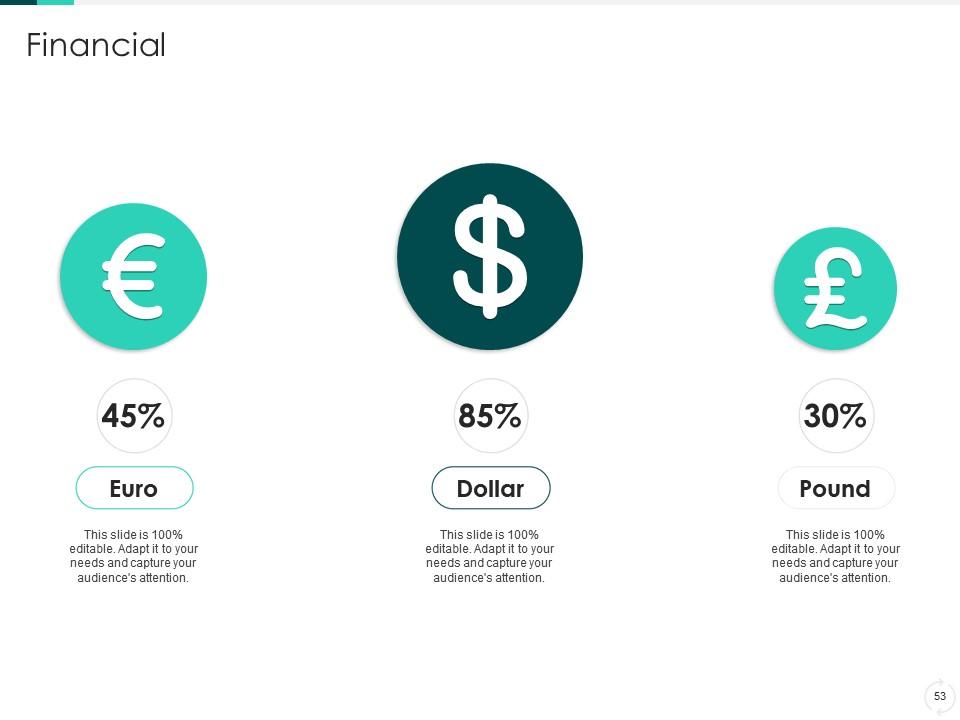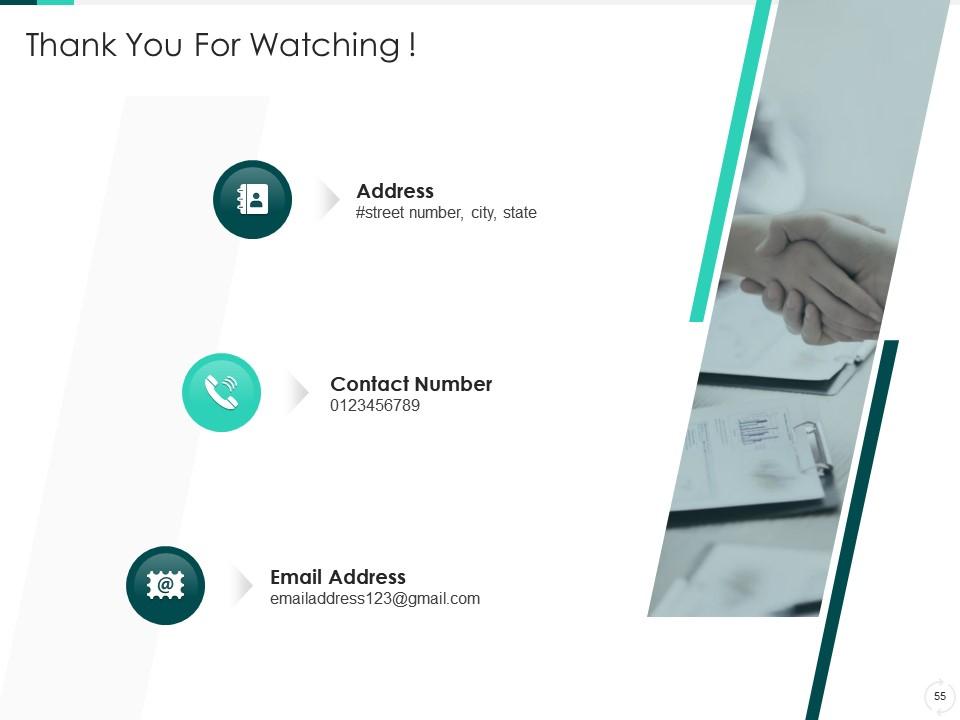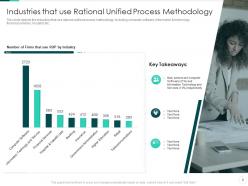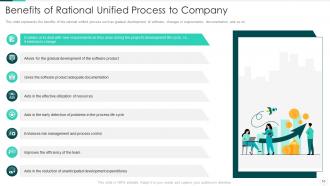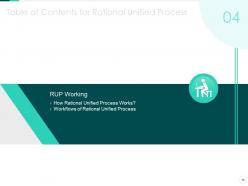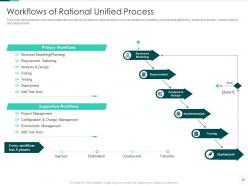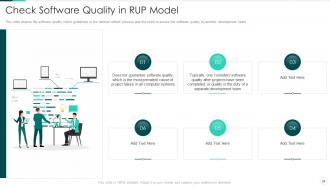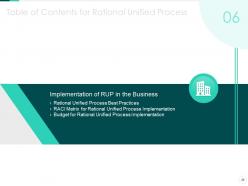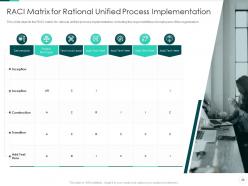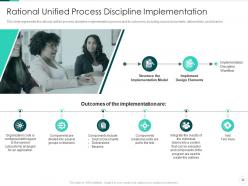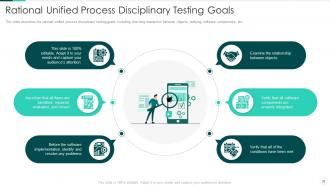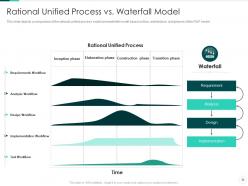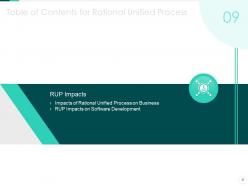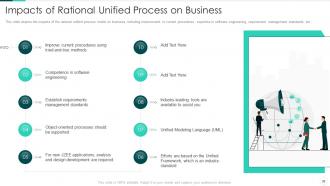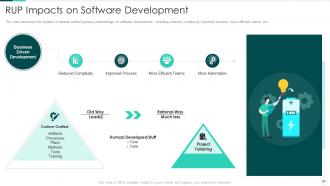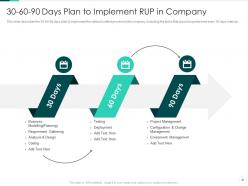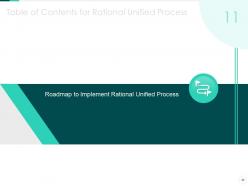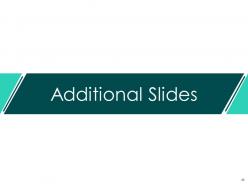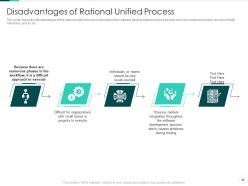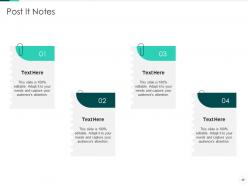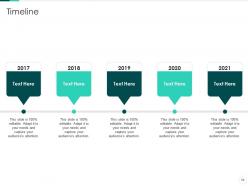Rational unified process it powerpoint presentation slides
The Rational Unified Process RUP is an agile software development technique that divides a projects life cycle, or software development, into four phases. To successfully implement the agile methodology, it becomes crucial for you to have a step by step guide in place, which is where this module exists. It talks about various stages, including Modeling, analysis, design, implementation, testing, and application. The template addresses the problems faced by software development companies by presenting the statistics in a bar graph. Also, it talks about using RUP methodology to overcome the issues. This proposal covers the need for RUP implementation in the business, an overview of RUP by covering its various phases, and benefits and disadvantages. In addition, this template contains working of RUP a checklist to implement RUP in the company, best practices, RACI matrix, and a budget for the implementation. Furthermore, this proposal includes the RUP disciplines and comparison of RUP with other models such as Waterfall and Scrum. Moreover, it caters to the impacts of RUP implementation on business and software development. Lastly, this RUP Methodology deck comprises a 30-60-90 days plan to implement RUP in the company and a roadmap. Download our 100 percent editable and customizable template.
- Google Slides is a new FREE Presentation software from Google.
- All our content is 100% compatible with Google Slides.
- Just download our designs, and upload them to Google Slides and they will work automatically.
- Amaze your audience with SlideTeam and Google Slides.
-
Want Changes to This PPT Slide? Check out our Presentation Design Services
- WideScreen Aspect ratio is becoming a very popular format. When you download this product, the downloaded ZIP will contain this product in both standard and widescreen format.
-

- Some older products that we have may only be in standard format, but they can easily be converted to widescreen.
- To do this, please open the SlideTeam product in Powerpoint, and go to
- Design ( On the top bar) -> Page Setup -> and select "On-screen Show (16:9)” in the drop down for "Slides Sized for".
- The slide or theme will change to widescreen, and all graphics will adjust automatically. You can similarly convert our content to any other desired screen aspect ratio.
Compatible With Google Slides

Get This In WideScreen
You must be logged in to download this presentation.
PowerPoint presentation slides
Deliver this complete deck to your team members and other collaborators. Encompassed with stylized slides presenting various concepts, this Rational Unified Process IT Powerpoint Presentation Slides is the best tool you can utilize. Personalize its content and graphics to make it unique and thought-provoking. All the fifty five slides are editable and modifiable, so feel free to adjust them to your business setting. The font, color, and other components also come in an editable format making this PPT design the best choice for your next presentation. So, download now.
People who downloaded this PowerPoint presentation also viewed the following :
Content of this Powerpoint Presentation
Slide 1: This slide displays title i.e. 'Rational Unified Process (IT)' and your Company Name.
Slide 2: This slide presents agenda.
Slide 3: This slide exhibits table of contents.
Slide 4: This slide shows title for 'Current situation of the company'.
Slide 5: This slide depicts the software development problems experienced by the company.
Slide 6: This slide represents the cost of rectifying and fix software problems after deployment.
Slide 7: This slide highlights title for 'Need for RUP Implementation'.
Slide 8: This slide depicts the industries that use rational unified process methodology.
Slide 9: This slide represents the companies who deployed rational unified process model by company size.
Slide 10: This slide represents the benefits of the rational unified process.
Slide 11: This slide displays title for 'Overview of RUP'.
Slide 12: This slide represents a rational unified process and how it helps prevent resource waste and unexpected development expenses.
Slide 13: This slide depicts the rational unified process building blocks.
Slide 14: This slide represents the various phases of the rational unified process.
Slide 15: This slide depicts the detailed phases of the rational unified process.
Slide 16: This slide presents title for 'RUP Working'.
Slide 17: This slide depicts the working of the rational unified process.
Slide 18: This slide represents continued content.
Slide 19: This slide describes the main and supportive workflows of rational unified process.
Slide 20: This slide exhibits title for 'Checklist to implement RUP in business'.
Slide 21: This slide represents the requirements management guidelines for the rational unified process model.
Slide 22: This slide depicts the use of a component-based architecture with the rational unified process.
Slide 23: This slide illustrates the use of visual software models in the RUP model.
Slide 24: This slide depicts the software quality check guidelines in the rational unified process.
Slide 25: This slide represents how management and control change software is easy in the rational unified process.
Slide 26: This slide shows title for 'Implementation of RUP in business'.
Slide 27: This slide depicts the best practices for the rational unified process.
Slide 28: This slide depicts the RACI matrix for rational unified process implementation.
Slide 29: This slide depicts the budget for rational unified process implementation by resources.
Slide 30: This slide highlights title for 'RUP Disciplines'.
Slide 31: This slide depicts the disciplines of the rational unified process methodology.
Slide 32: This slide represents the rational unified process discipline implementation process and its outcomes.
Slide 33: This slide describes the rational unified process disciplinary testing goals.
Slide 34: This slide displays title for 'RUP & other methodologies'.
Slide 35: This slide depicts a comparison of the rational unified process model and waterfall model.
Slide 36: This slide depicts the rational unified process and scrum methodology.
Slide 37: This slide presents title for 'RUP Impacts'.
Slide 38: This slide depicts the impacts of the rational unified process model on business.
Slide 39: This slide describes the impacts of rational unified process methodology on software development.
Slide 40: This slide exhibits title for '30-60-90 days plan for implementation'.
Slide 41: This slide describes the 30-60-90 days plan to implement the rational unified process in the company.
Slide 42: This slide shows title for 'Roadmap for implementation'.
Slide 43: This slide depicts the roadmap to implement the rational unified process in the organization.
Slide 44: This is the icons slide.
Slide 45: This slide presents title for additional slides.
Slide 46: This slide shows the disadvantages of the rational unified process that makes the software development process a bit slow.
Slide 47: This slide exhibits weekly line charts for different products. The charts are linked to Excel.
Slide 48: This slide displays monthly sales area charts for different products. The charts are linked to Excel.
Slide 49: This slide depicts posts for past experiences of clients.
Slide 50: This slide presents your company's vision, mission and goals.
Slide 51: This slide shows targets.
Slide 52: This slide displays puzzle.
Slide 53: This slide showcases financials.
Slide 54: This slide exhibits yearly timeline.
Slide 55: This is thank you slide & contains contact details of company like office address, phone no., etc.
Rational unified process it powerpoint presentation slides with all 55 slides:
Use our Rational Unified Process IT Powerpoint Presentation Slides to effectively help you save your valuable time. They are readymade to fit into any presentation structure.
FAQs
RUP stands for Rational Unified Process, and it is a software development methodology. It helps prevent resource waste and unexpected development expenses by breaking the development process into phases, each with its set of goals and deliverables. This allows for better planning and management of resources and helps avoid costly surprises.
The building blocks of RUP are the artifacts, activities, roles, and workflows. Artifacts are the documents and deliverables produced during the development process. Activities are the tasks performed by individuals or teams to produce those artifacts. Roles are the responsibilities assigned to individuals or teams. Workflows are the sequence of activities and artifacts that produce a result.
The phases of RUP are Inception, Elaboration, Construction, and Transition. Inception is the initial stage where the feasibility of the project is evaluated. Elaboration is where the requirements are analyzed, and the architecture is designed. Construction is where the actual coding takes place. Transition is when the product is released to the market.
Some best practices for implementing RUP in a business include having clear goals and objectives, involving all stakeholders, using a component-based architecture, using visual software models, maintaining software quality, and having a change control process in place.
RUP is an iterative and incremental methodology that focuses on managing complexity, while the waterfall methodology is a linear approach that focuses on completing each phase before moving on to the next. Scrum is an agile methodology that focuses on collaboration, flexibility, and quick delivery of working software. RUP is more structured and formal than Scrum but less rigid than the waterfall methodology.
-
Best Representation of topics, really appreciable.
-
Good research work and creative work done on every template.
-
Enough space for editing and adding your own content.
-
Topic best represented with attractive design.
-
Graphics are very appealing to eyes.


